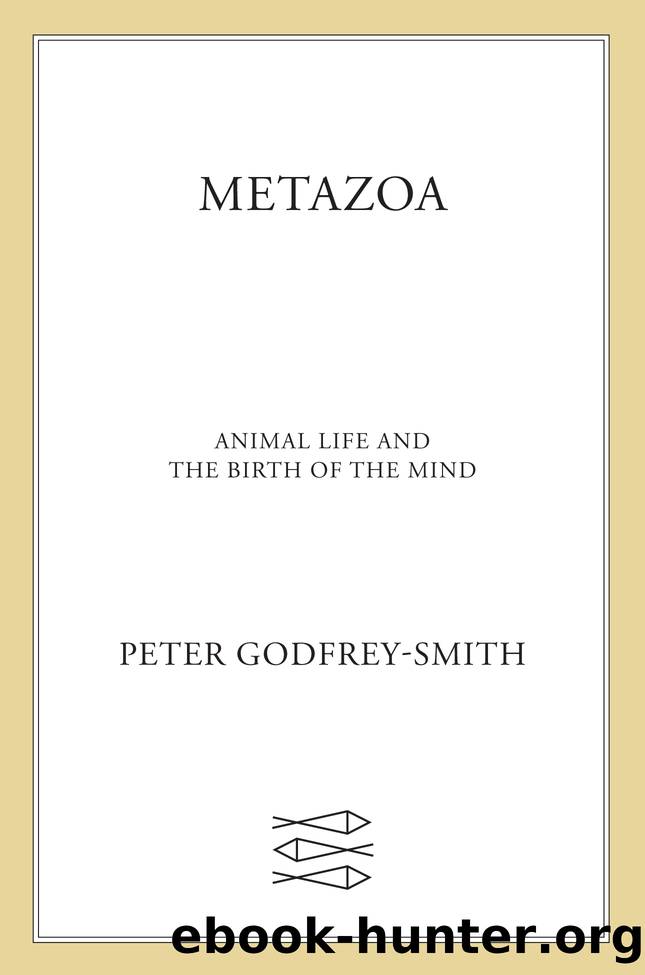Metazoa by Peter Godfrey-Smith

Author:Peter Godfrey-Smith
Language: eng
Format: epub
Publisher: Farrar, Straus and Giroux
A field does look like the right sort of thing to help us with the puzzle of consciousnessâa warm invisible glowing area, centered on the brain but spreading from it, a blur of energy in our heads. That blur seems to have a more experience-like shape than the rest of what has been uncovered in our skulls. But a field canât solve the problem just by being a special sort of stuff. It would have to do things of the right kind.
The mental image we fall into, when imagining these fields, is a sort of physicalized Rothko experience, a blurry wash of qualia. That very fact should alert us that we are falling into a relative of the fallacious moves I diagnosed back in Chapter 5, when the materialist was asked to find a way to conjure colors and sounds out of dark and silent machinery. That Chapter 5 error was cured, in part, by noting that conscious experience is the first-person point of view of a living system of a certain kind, not something conjured up by the workings of that system, something that might be seen from the outside if we knew where to look. That erroneous framework is hard to entirely discard, though, and when we find invisible fields in the brain, we seem to have been given a better material for a conjuring of color and sound, and it is tempting to try it all again. Tempting, but still a mistake.
However, I think that these discoveries do make a difference to the project of explaining experienceâcertainly the rhythms, and perhaps the fields. First, they change our picture of what sort of thing a brain is.
The way to make this clear is with the starkest contrasts. There is an old but still common picture of the brain in which it is seen as a large and complicated signaling network. For example, people used to compare a brain to an automated telephone exchange. That analogy is nearly as old as telephone exchanges themselves; the English scientist Karl Pearson made the comparison so early, in 1900, that automation was not in the picture and he had to imagine human operators manually making the connections. Later views imagined a switching network that wires itself automatically. A common view expressed by neuroscientists (I remember hearing this expressed very firmly by a Harvard neuroscientist around 2010) is that if we knew all the local signaling pathways from one neuron to another in a brain, we would have a complete understanding of what that brain does. This image of a signaling network has seemed almost inescapable to many people looking at brains, but it has often seemed a bit antithetical to explaining conscious experience. And as far as I can tell, this view of the brain is changing.
The work I have been describing here in this chapter gives us a quite different picture. A brain is a biological organ with self-generated electrical activityârhythmic, often synchronized, modulated by the senses. Cells in the nervous system other than neurons, such as astrocytes, have subtle but increasingly noticeable roles.
Download
This site does not store any files on its server. We only index and link to content provided by other sites. Please contact the content providers to delete copyright contents if any and email us, we'll remove relevant links or contents immediately.
Invention by James Dyson(725)
Thinking Better by Marcus du Sautoy(681)
The Ten Equations That Rule the World by David Sumpter(674)
Concepts of Space by Jammer Max;(656)
God and the Multiverse by Victor J. Stenger(632)
Wanting by Luke Burgis(627)
Merchants of Doubt by Erik M. Conway(625)
How We Got to Now by Steven Johnson(602)
Factfulness by unknow(562)
The Surrender Experiment by Michael A. Singer(540)
The Smallest Lights in the Universe by Sara Seager(514)
On Creativity by Bohm David(490)
Floods, Famines, and Emperors: El Nino and the Fate of Civilizations by Brian Fagan(482)
Ancient Knowledge Networks by Eleanor Robson;(480)
Why Birds Matter by University of Chicago Press(472)
The Science of Being Lucky: How to Engineer Good Fortune, Consistently Catch Lucky Breaks, and Live a Charmed Life by Peter Hollins(463)
The Scientist and the Psychic by Christian Smith(463)
The Oxford Handbook of Philosophy of Mathematics and Logic by Stewart Shapiro(453)
Flood by Design (Design Series) by Mike Oard(428)
